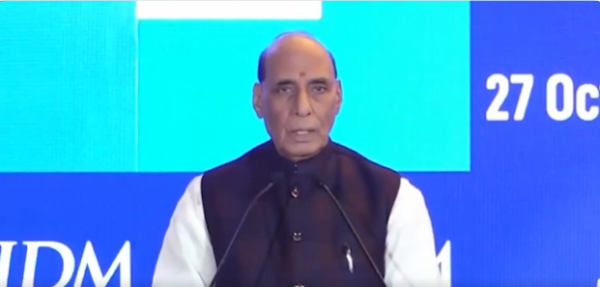News
India Eyes ₹30,000-Crore Defence Export Milestone by March 2026, Says Rajnath Singh

India’s defence exports are poised to hit a record ₹30,000 crore ($3.6 billion) by March 2026, Defence Minister Rajnath Singh said on Monday, crediting the effective use of indigenous weapon systems during Operation Sindoor for bolstering the country’s global standing and accelerating demand for Made-in-India military equipment.
Addressing the annual session of the Society of Indian Defence Manufacturers (SIDM), Singh said the success of Operation Sindoor — in which the Indian Armed Forces deployed systems such as the Akash missile, BrahMos, and the AkashTeer Air Defence Control System — had demonstrated the operational strength and export potential of India’s home-grown platforms.
“The world has seen the power of India’s indigenous defence systems,” Singh said. “Our defence production, which stood at ₹46,000 crore in 2014, has increased to ₹1.51 lakh crore ($18.1 billion) today, with the private sector contributing ₹33,000 crore ($4 billion). Defence exports that were under ₹1,000 crore a decade ago have now surged to around ₹24,000 crore ($2.9 billion).”
The minister said the government’s goal was to ensure that India evolves from an assembly hub into a true manufacturing powerhouse — “Made in India, Made for the World.”
Exports at the Core of Self-Reliance Push
The export surge is part of a broader policy shift aimed at positioning India as a net defence exporter. Singh said the private sector’s role must grow from 25% of total production to at least 50% within the next three years to sustain the momentum.
“Our focus should be on manufacturing individual subsystems and components, not merely assembling final platforms,” he said. “By dominating the supply and maintenance chains, India can cut lifetime dependence on foreign suppliers and strengthen strategic autonomy.”
Defence exports have been driven by sales of artillery guns, radars, armoured vehicles, and missile systems to countries in Southeast Asia, Africa, and Latin America. Government data shows that exports to friendly nations have risen sharply following India’s inclusion of 500-plus items on a positive indigenisation list, which restricts imports and promotes domestic alternatives.
Operation Sindoor: A Showcase of Indigenous Strength
Operation Sindoor, conducted earlier this year in response to cross-border hostilities, became a turning point for India’s defence manufacturing story. The deployment of Indian-designed systems impressed both regional and Western observers, with several foreign delegations reportedly seeking demonstrations and joint ventures with Indian manufacturers.
“The success of Operation Sindoor belongs not just to our brave soldiers but also to the ‘industry warriors’ who designed, built, and supplied these systems,” Singh said. “It should serve as a case study for our future course — that preparedness and deterrence must be built on our own foundations.”
The minister added that modern warfare’s evolving nature — from cyber to space and drone-based conflict — requires India to achieve technological dominance, not dependency.
A Global Strategy Amid Rising Uncertainty
Singh underscored that global instability — from conflicts in Europe and the Middle East to disruptions in supply chains — had made indigenisation a strategic imperative. “The established world order is weakening, and conflict zones are multiplying. India must redefine its security and strategy accordingly,” he said.
He noted that initiatives like the Quantum Mission, Atal Innovation Mission, and the National Research Foundation are helping create an innovation-driven defence industrial base. “Our aim is not just to assemble parts but to develop end-to-end systems that the world wants to buy,” he said.
Policy Support for Defence Export Growth
The government recently launched the Defence Procurement Manual 2025 and is revising the Defence Acquisition Procedure 2020 to simplify procurement and boost private participation.
These reforms, along with liberalised export clearances, offset policy revisions, and industry-led design programs such as iDEX (Innovations for Defence Excellence) and ADITI (Acing Development of Innovative Technologies), are expected to further accelerate exports.
“No country can progress without innovation and R&D,” Singh said. “We are challenging our industry to develop large-scale, end-to-end technological products. If we work together, the entire landscape of India’s defence sector will transform.”
From Importer to Exporter
Before 2014, India was among the world’s largest defence importers, relying heavily on foreign suppliers for almost all critical systems. Over the past decade, New Delhi has systematically tightened import curbs and offered incentives for domestic design, development, and exports.
India now exports to over 85 countries, and defence PSUs such as Hindustan Aeronautics Ltd (HAL), Bharat Electronics Ltd (BEL), and private players like Larsen & Toubro and Tata Advanced Systems are emerging as key exporters.
With growing interest in Indian-built missile systems, helicopters, and naval vessels, analysts expect the country to enter the top 20 global defence exporters within the next five years.
“Our Soil, Our Shield”
Singh concluded with a call to make “our soil, our shield” the nation’s first choice. “Self-reliance is the only way to deal with emerging challenges,” he said. “India’s defence sector is no longer an assembly line for foreign products. It’s becoming a global manufacturing and innovation hub.”
If current trends hold, India could not only meet its ₹30,000-crore export target by 2026 but also redefine itself as a net security provider in the Indo-Pacific — a role long dominated by Western arms manufacturers.
